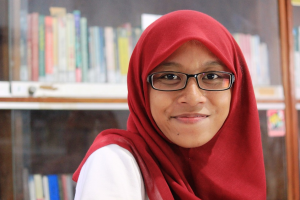 “Public schools are the de facto experience for immigrant children to be part of this country, both to learn about and participate in the nation,” says Nimo Abdi, a faculty member in the Department of Curriculum and Instruction, noting that public schools are the first place where immigrant children contact mainstream culture and learn ways to integrate.
“Public schools are the de facto experience for immigrant children to be part of this country, both to learn about and participate in the nation,” says Nimo Abdi, a faculty member in the Department of Curriculum and Instruction, noting that public schools are the first place where immigrant children contact mainstream culture and learn ways to integrate.
Abdi’s research focuses on the intersectionality, or interconnected nature of social categorizations such as race, class, and gender, as they apply to the immigrant student. She is interested in how context shapes the identities of students. And what she has found is that the impact of schooling cannot but understated for students that are new to this country.
Preconceptions Hurt Immigrant Students
Abdi is studying the Somali community in Columbus, Ohio which is very similar to the one here in the Twin Cities. She sees Somali students face the obstacle of preconceived notions based on their background in the Columbus public schools. “Teachers and school administrators and students have certain concepts of what it means to be a Somali,” Abdi says.
As a science teacher in Columbus, Abdi noticed that students were treated differently based on their appearance. Russian immigrant students were mainstreamed into regular classes even if they needed the help of an ESL class. However, second-generation Somali students were still being placed in ESL classes even if they were proficient.
“Those things tend to mark and label students in a certain way—being visible, being black and Muslim, and also being Somali,” Abdi finds in her experience and research.
Caught Between Two Cultures
Somalis students deal with the dual pressure of having to fit into their schools and into their home communities by changing their identities in different contexts. “In urban settings, some Somali students appropriate hip-hop culture to be part of the black youth culture,” says Abdi, noting that they are not necessarily accepted completely not do they see themselves as such.
“One boy told me that sometimes he identified as Somali, sometimes as African-American. It all depends on the context. “
Trying to fit into the school and home community is especially difficult for girls. “Girls come to school completely covered, and in literally less than ten minutes they take everything off and look completely different,” Abdi says that “the tricky thing about the whole notion of dress code is it could have completely different meanings in different settings. Covering is appreciated in the Somali context as a show of modesty but it has the opposite effect in mainstream culture. It’s a very difficult for young children to navigate that.”
Creating Spaces for Immigrant Students
In order to help immigrant students thrive in the educational system, Abdi believes that schools need to create spaces for all children, by educating students about different religions and offering options for students who don’t conform to the majority religion. She believes that a culturally responsive pedagogy could go a long way towards helping to integrate immigrant children and their communities.
“Social categories have real-life consequences in people’s lives. Being labelled in a certain way, has real meaning for children and how they see themselves,” Abdi reveals the main finding of her research: “The context of our education shapes who we are and how we see the world.”
Find about more about teacher education programs designed to support immigrant students in the Department of Curriculum and Instruction.



